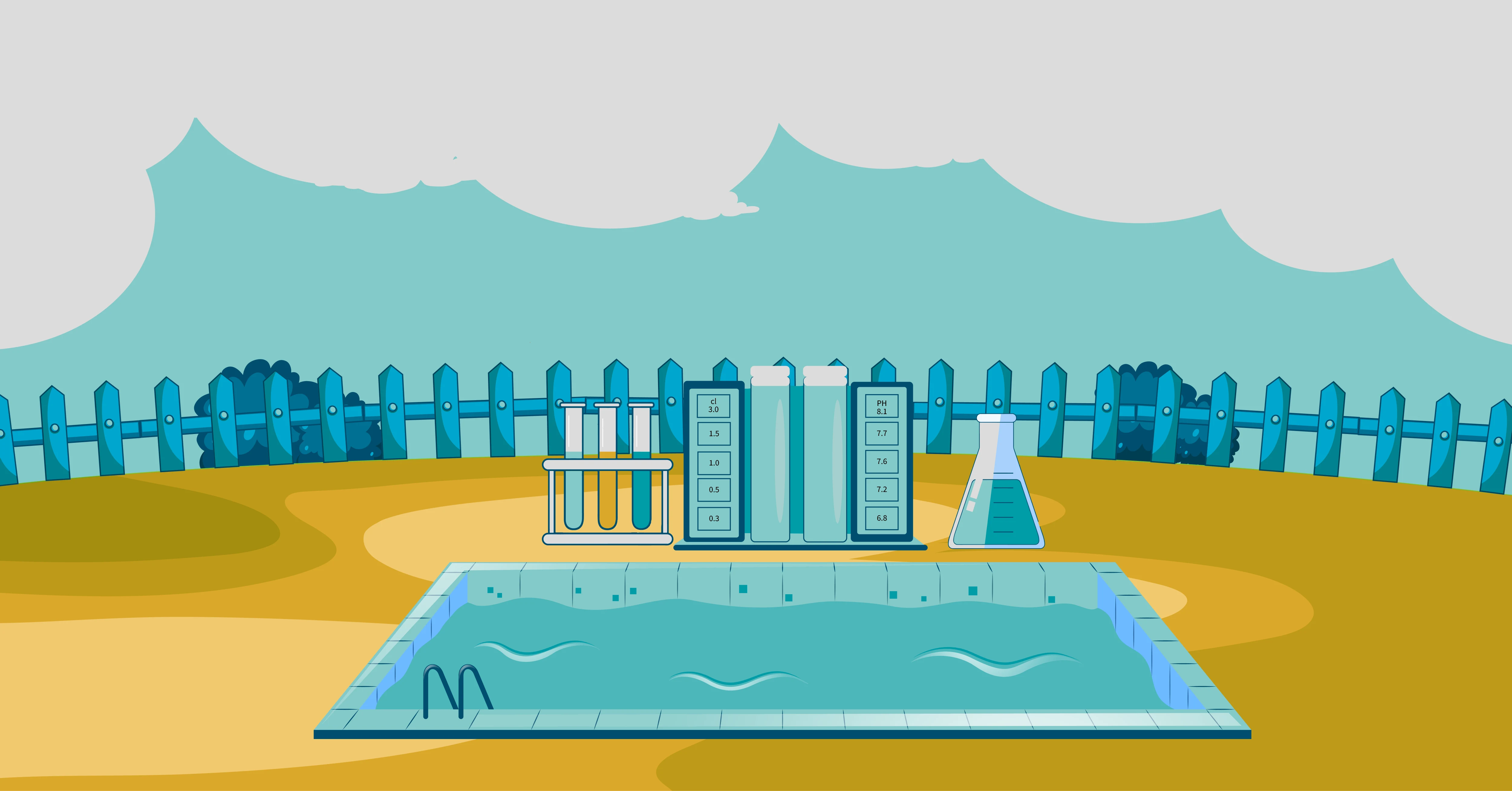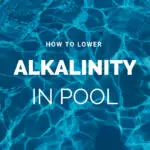Wondering how to lower alkalinity in pool? Most people deal with the issue of having low alkalinity in the pool. In all, if you need to raise your alkalinity, you will have a bit of a more manageable project on your hands. When it comes time to lower your pool alkalinity, the project can be a little more delicate.
Let’s look at some of what causes this high pool alkalinity and what you can do to fix it.
What Is Alkalinity in Water?
Alkalinity in pool water is a measure of how basic or how acidic the water is. If your alkalinity is high, it means that your pool water is very basic. The alkalinity and the pH are very closely tied together, and when you change one, you will undoubtedly impact the other.
Why Should You Bother Lowering Alkalinity?
Most of the time, total alkalinity will lower on its own. This is a great thing about this issue, but it is vital to get your alkaline levels checked as soon as possible. When the alkalinity is off, the ph levels are also going to be off.
With the high total alkalinity, you run a risk of building scale in your pool filter and pipes. This scaling will build up in your circulation system and reduce water flow. When water flow is reduced, the swimming pool will be subject to more bacteria and algae growth issues making the water cloudy and high in calcium hardness.
Causes of High Pool Alkalinity
Before we get started fixing your pool chemistry, let’s figure out how you got to this position in the first place. There are a few reasons that your pool alkalinity level could be too high.
1. Overdoing the Pool Shock
Pool shock is known for being a highly alkaline substance. If you have just shocked your pool, chances are the total alkalinity could be on it’s way up just because of this. When you start the chlorine shock process for your swimming pool, make sure that you are using the proper amount.
2. Increase in pH
As we mentioned, alkalinity and pH are going to go hand in hand. If your swimming pool just experienced quite a few extra users, chances are your pH level could be a little off. The pH levels in your pool are often affected by people that are swimming in the pool and the lotions and oils that come off of them.
3) Water Source
Did you add water to your swimming pool? Chances are the issue could be stemming from the water source. Sometimes, the water you are putting in the pool has high total alkalinity, affecting your swimming pool water. There won’t be too much you can do about this except to keep a close eye on the pH and TA (Total Alkalinity).
How to Test Your Total Alkalinity Readings Accurately
The majority of the time, you need to lower your total alkalinity; you will have to deal with muriatic acid or sodium bicarbonate. Neither of these is all that fun to work with. It certainly makes sense to ensure that your total alkalinity in your swimming pool needs help before you start adjusting these levels.
Use pool test strips or a test kit to understand the pH and alkalinity level in your pool or hot tub. Test kits give a much more accurate water test and can check for levels of free chlorine, total chlorine, bromine, calcium hardness, and cyanuric acid.
The testing should not be done directly after shocking your swimming pool. We would also retest in 24 hours before starting to use acid to lower the pH and alkalinity.
- [Reliable + Accurate] - High-quality sensors and temperature compensation for accuracy and reliability. Automatic temperature compensation (ATC) ensures accuracy in all testing modes.
- [TDS and EC] - Measure PPM and pH in hydroponics, aquarium, pools, water, wine making, and more. Kit includes buffering powders and video instructions for recalibrating the pH meter.
- [pH Meter] - Measure the pH of any liquid from 0.00 -14.00. Meter features Automatic Temperature Compensation (ATC) and can be calibrated with the included buffer powders. A detailed how-to video on the...
- [Portable and Easy to Read] - The large, lighted, high-contrast display is easy-to-read in either bright sunlight, or under bright grow lights. The slim profile of these meters allows them to be easily...
How to Lower Alkalinity in Pool
There are a few methods that you can use to lower the high alkalinity in your swimming pool. Pool owners should always follow all safety precautions when lowering high alkalinity.
1. Muriatic Acid
Muriatic acid is the most common way to lower alkalinity. When you add muriatic acid to your pool, you will need to be very careful. Adding muriatic acid takes some serious safety precautions if you want to avoid injury.
The first step is always to get a baseline for your pool’s chemical balance. Swimming pools and hot tubs will change quite quickly, and you want to make sure that you really need to add muriatic acid before doing so. Once you see what your levels are, you can start calculating the amount of acid required.
We highly recommend diluting the acid in a bucket before you add it to your pool. Put some water in a bucket, add the muriatic acid, and then put this into the deep end of your pool. It would be best if you let your pool pump run for the first half-hour after placing the muriatic acid in the pool.
If this acid were to land on pool surfaces, it could do some real damage. Make sure that you don’t let the muriatic acid fall on the bottom of the pool, or it will start to deteriorate your pool. Make sure that you follow all safety precautions when working with muriatic acid.
- High-grade natural latex possess a excellent chemical resistance and tear resistance
- Ideal thickness provide a fantastic secure protection yet still tactile sensitive
- Only one size - extra large, but its smooth finish provides excellent grip
2. Sodium Bisulfate (Dry Acid)
Sodium Bisulfate is usually sold as a way to lower the total alkalinity in your pool without having to use muriatic acid. The sodium bisulfate is usually sold in the pool supply store, and although it can be useful, it is almost always a more expensive way to lower total alkalinity.
With Sodium Bisulfate, you won’t have to deal with a liquid form of acid, and it can help to make sure that you don’t get splashed with dangerous and highly toxic material.
3. Time
Suppose the above methods of lowering total alkalinity do not appeal to you. In that case, you can wait for the high pH and high alkalinity levels to drop on their own and regain the right balance of acidity. This can take quite a while, and it may not be something that you are willing to do, but it should eventually work out.
Tips for Achieving Lower Pool Alkalinity
The best thing you can do for pool maintenance and to keep your pool water alkalinity in check is to keep checking on your pool water. The alkalinity range will likely be affected after the pH is affected. If you can keep your pH level within range, your alkalinity levels should also be fine. This will help prevent staining and corrosion.
Also, make sure that you are checking your chlorine levels and shock levels often. If you happen to use too much chlorine or shock, you can raise the alkalinity levels unknowingly. Using too much cyanuric acid in your pool can also cause the TA level to be too high while lowering ph levels.
Another great way to bring your pH levels back up to normal is to aerate the water. Something as simple as a small fountain is enough to do the trick, and it’s aesthetically pleasing.
- Water feature and décor for most in-ground pools (check fitting size)
- Fully adjustable water spray height and direction; instructional video on this page shows how to quickly adjust
- Fits most 1.5-inch threaded return fittings, please check your pool’s fitting for compatibility
Lower Alkalinity in Pool FAQ
What Can I Use to Lower the Alkalinity in My Pool?
There are several pool care methods to lower alkalinity in swimming pool water. The methods are adding muriatic acid, adding sodium bisulfate, or waiting for the water chemistry to adjust itself. Lowering the pH is going to occur when you lower the total alkalinity of the water. You will want to make sure your total alkalinity is not higher than 120 parts per million.
Can You Use Baking Soda to Lower Alkalinity?
No, Sodium bicarbonate (baking soda) is going to increase the alkalinity in your pool water. If you add baking soda to the water, you may end up making this issue worse for yourself and your pool equipment. Always take a water sample before adding anything to your pool to ensure that you will not make your problems worse.
Does Chlorine Lower Alkalinity?
As we mentioned, when you shock your pool, the TA (total alkalinity) can increase. However, if you are using your regular chlorine tablets, granular chlorine, or liquid chlorine, it should help keep your TA in check. When chlorine is dissolved, it can help to lower the TA in your pool.
Will Alkalinity Decrease on Its Own?
Alkalinity levels will eventually decrease on their own. The amount of time that this takes to happen can be a while. If your total alkalinity is above 120 ppm, you may want to lower it before damage is done to your pool.
What Should Be Adjusted First, Alkalinity or PH?
It is nearly impossible to lower the alkalinity without decreasing the pH in the pool. Work on getting the alkalinity levels in check, and then you can increase pH if necessary.
How to Lower Alkalinity in Pool Without Affecting PH?
You are going to affect the pH level when you add muriatic acid and change the TA. This is a known fact. The only thing you can do to keep the pH level more in check is to turn the pool pump off after adding the muriatic acid. Be careful doing this as it could cause damage to the pool walls or floor. Most people find it easiest to lower the TA and then work on ways to raise the pH. This entire process can take a bit of time.
Can You Swim in a Pool With High Alkalinity?
The most important thing when it comes to swimming is to ensure that the chlorine level and the pH level are within a safe range. If these levels are where they should be, you should swim even if the TA in the water is too high. If you are ever concerned about your water’s safety, you can have it tested at a local pool supplier to be sure.

For over 15 years, Sean Moore has been sharing his love and enthusiasm for swimming pools and hot tubs with everyone he knows. His goal is to help everyday people DIY their maintenance to save money by teaching how to properly take care of your equipment, safely and correctly balance chemicals, and extend the life of your water oasis.
Pricing on this page was last updated on 2024-04-26






